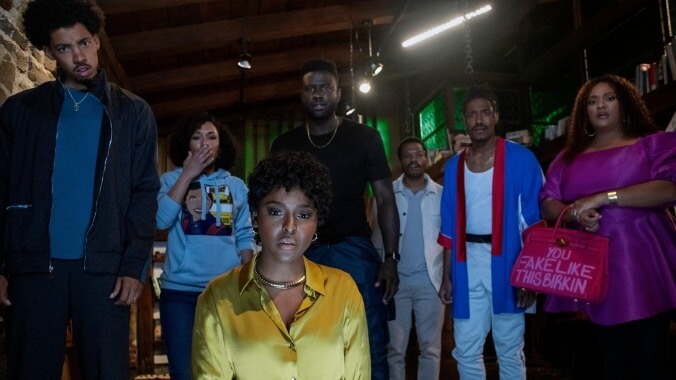The Blackening review: Slasher satire slaughters tired tropes
Director Tim Story's hilarious horror parody wonders how the Black character can die first when all the characters are Black

A satire that begins with its title, The Blackening relentlessly “uses humor, irony, exaggeration, to expose and criticize stupidity.” That is, of course, the Oxford dictionary definition of the word “satire” and the filmmakers may very well have referenced it when writing this wonderfully pointed film about the relationship between Black folks and slasher movies. It’s a relationship fraught with indignities, most notably the well-worn trope of the Black character always dying first or worst—if not both. If the latter, they oftentimes die worse than the killer, who may not die at all. The Blackening, with insight and humor, posits the question: when everyone in the horror movie is Black, can anyone survive, or must everyone die?
In the film, directed by Tim Story (Ride Along, Barbershop), a group of college friends reunites for a Juneteenth celebration at a location that, in and of itself, is another trope; a remote cabin in the woods. One doesn’t have to be a Black critic like myself to know why this is funny but, just in case, the joke is that Black people never go to remote cabins in the woods on purpose—except in slasher movies. This “fact” that “everybody knows” is noted by every character in The Blackening (including a white guy) and is funny every time it’s mentioned. It’s always been a way for Black folks to account for no Black actors being in horror movies because that’s easier to accept than the notion that the filmmakers didn’t know any Black people.
Referencing any number of mainstream horror films, the prologue of The Blackening begins with Jay Pharoah and Yvonne Orji (SNL and Insecure, respectively) in an homage to, and commentary on, the Scream prologues. Arriving at the cabin early to prepare for the reunion, they note the board game adorned with what in the Antebellum South was called a Sambo caricature. The racist black-faced image then speaks and calls them “to play a game.” So it goes, as Black folks do things that Black folks declare they would never do in a horror movie while hilariously commenting on themselves doing those very things.
As the rest of the friends arrive, each with their own issues and internecine relationships, they are drawn into a series of games that will test their “Blackness.” There are quizzes and quests that most audiences will find humorous, although they resonate on a deeper, less funny level to Black audiences. For instance, one life-or-death question posed requires the trapped friends to name a Black character on the sitcom Friends. Most Black folks know the answer to this question and it’s not what most white folks think it is, which makes it even funnier.







































